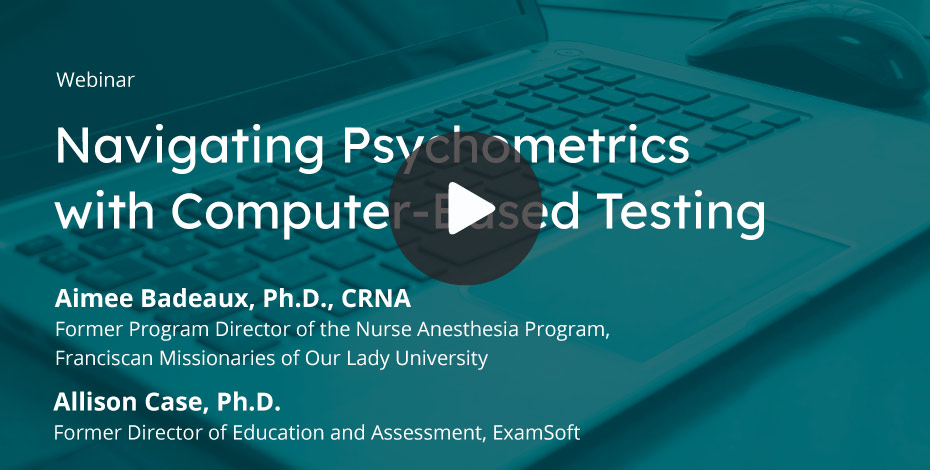Category tagging — or connecting individual exam items to specific content areas such as accreditation standards, learning outcomes, and programmatic objectives — is not only beneficial to students, but to exam-makers and instructors as well. Even entire programs can reap the benefits of category tagging for assessment.
Opportunities for Category Tagging
Exam-makers have virtually unlimited options when it comes to category tagging with ExamSoft. For instance, exam-makers can support student success in future academic programs and even careers by tagging exam items to certain content areas or competencies.
Faculty can also tag items to instruction methods. If questions are tagged to teaching strategies, instructors can see which are working and which aren’t. For example, if a large part of the class performed poorly in a content area that was taught through lecture (i.e., passive learning) but responded well to a student-led method such as the flipped classroom, the instructor can make necessary adjustments to their teaching strategy for the next section of the course.
ExamSoft provides reports that drill down to individual student performance. Instructors can use these reports to identify where a student is struggling and provide timely remediation to improve learning outcomes, increase retention, and build for future success.
Exam items can also be tagged to accreditation standards. If a course seems to be underperforming in a particular area, instructors can adjust teaching methods, revisit course material in class, and fill curriculum gaps to support programmatic goals.
Many programs have internal standards of excellence that they strive to achieve. In the same way that exam-makers tag items to categories related to accreditation criteria, they can also tag items to programmatic standards and track performance across courses.
One of the most beneficial ways to use category tagging is to connect exam items to Bloom’s Taxonomy of learning outcomes.
Tagging Exam Items to Bloom’s Taxonomy
Curriculum designers, instructors, and other education professionals use Bloom’s Taxonomy as a framework for classifying educational objectives. This framework, organized from lower- to higher-level objectives, helps educators break down the learning process, which in turn helps them teach more effectively.
The levels of Bloom’s Taxonomy (revised 2001) are as follows — from lowest to highest:
- Remember
- Understand
- Apply
- Analyze
- Evaluate
- Create
With ExamSoft’s category-tagging feature, instructors and other stakeholders can tag exam items to each of these learning objectives to get a macro view of student progress. Tagging questions to Bloom’s allows instructors to find any disconnects in student learning. For example, a student may perform well on exam items tagged to levels 1 – 4, but struggle with items tagged to the upper levels. In this case, the instructor can focus remediation efforts on the transition from analyzing to evaluating and creating.
With any high-stakes exam, it’s important to focus on higher-order thinking, such as the ability to create something new based on the knowledge presented. By tagging items to Bloom’s, exam-makers can also use reports to determine if exam content is an appropriate level of difficulty for the exam’s objective (e.g., Are students getting enough of the top levels of Bloom’s pyramid?) Instructors can also use psychometric reporting tools to track the difficulty index of specific exams or longitudinal analysis to observe difficulty level over time to align statistical to perceived difficulty.
Tangible Examples of Categories
Exam-makers can tag items to any category deemed important or pertinent to their program. Let’s take a look at nursing preparation, specifically regarding NCLEX readiness, as an example.
Here are a few of the competencies nursing graduates are expected to know to pass the NCLEX:
- Collaboration
- Concepts of management
- Health promotion
- Health maintenance
- Lifestyle choices
- Community health
Nurse educators can tag exam items to one or more of these learning objectives. After generating the performance reports, they can identify gaps in curriculum, adjust questions to better fit desired outcomes, provide early remediation to students who may need it, and more. When items are tagged to specific exam objectives and instructors take data-based action, nursing students are much better prepared for the NCLEX.
The same can be said for law, medical, or any other type of program where students must complete a certification or licensure exam graduation.
Bringing Your Data Together
This assessment data isn’t as valuable without clear reporting to make that data actionable, and ExamSoft offers a variety of reports for instructors, administrators, and students.
Strengths & Opportunities Reports: For students to improve, they must first know where their challenges lie. Strengths & Opportunities Reports give students a detailed view of exam performance. For example, if a student is notified that they scored an 85% on an assessment, they won’t know where they struggled without a detailed report of the exam. With category tagging, students can see which content areas they’ve mastered and the areas they should spend more time on. This allows students to focus their study habits more effectively.
Advanced Reports: Comprehensive reporting tools give instructors and exam-makers insights into every aspect of exam, category, and student performance.
- Student Category Performance Report: This report shows how exam-takers performed in specific categories across multiple assessments, allowing instructors to track improvement or identify areas of the curriculum where students began and continue to struggle.
- Category Performance: The category reports reveal how each category “performed” across exams over time, giving instructors the opportunity to spend more time on categories that underperform across the board.
- Course Performance Report: Course Performance Reports provide a longitudinal view of performance, customizable to show data for a specific course, every course within a department, or all departments inside a program. With this information, stakeholders can make the adjustments necessary to improve outcomes of students, courses, and the program as a whole.
Experience the Benefits of Category Tagging
The benefits are simple. Category tagging and the resulting reports help improve student learning outcomes, course and program performance, and quality of instruction — all of which supports accreditation efforts, student retention, and programmatic success.
ExamSoft gives programs the flexibility to make adjustments as they grow. Exam-makers and instructors can re-tag items at any point to gather the data they need to reach their goals. And unlike other solutions, ExamSoft’s all-in-one platform streamlines every aspect of the assessment process, from exam creation, management, and analysis to secure delivery in any environment.






